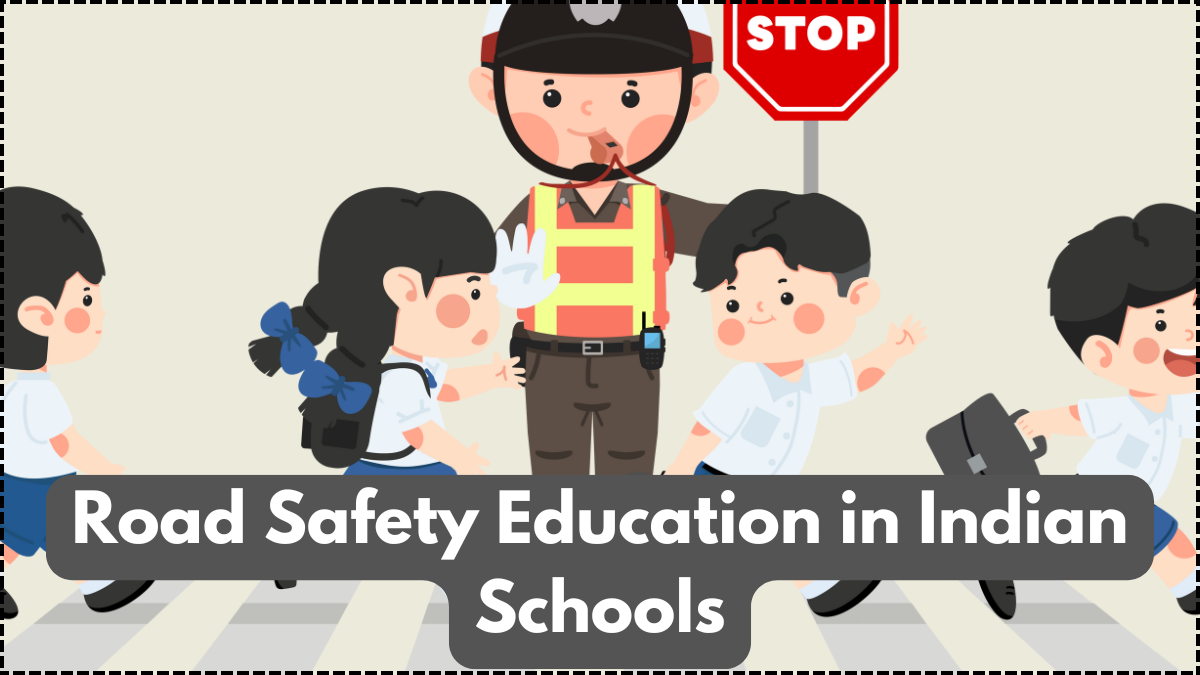In 2025, road safety has become an essential component of school education across India. With the increase in vehicular traffic and accidents involving children, the government has made road safety education in schools a national priority. Today’s curriculum goes beyond books and includes practical modules and traffic rule awareness programs designed to shape responsible future citizens.
This progressive shift is helping students not just learn the theory but also apply safety practices in real-life scenarios. Schools, in partnership with local authorities and transport departments, are organizing dynamic safety modules, practical demonstrations, and interaction with traffic officers to make learning engaging and impactful.

Why Road Safety Education Is Crucial in 2025
Children are among the most vulnerable road users. Many commute daily through busy intersections, often without adult supervision. Integrating road safety education in schools builds early awareness and life-saving habits. The government now mandates that road safety lessons be included at every school level, starting from primary classes.
Key reasons why this is necessary:
-
India ranks among the top countries for road accidents
-
Many accidents involve children as pedestrians or cyclists
-
Awareness reduces reckless behavior near roads and traffic zones
-
Educated children influence family and community behavior
The structured inclusion of traffic rule awareness programs ensures children grasp both the importance and the practical applications of safe road use.
Key Features of 2025 Traffic Education Programs in Schools
The 2025 modules are tailored to be student-friendly and include various formats to ensure better retention. Here’s how road safety education in schools is being implemented:
-
Interactive Traffic Seminars: Officers visit schools to talk about real-life traffic situations.
-
Street Simulation Zones: Mock zebra crossings, traffic signals, and signage in playgrounds.
-
Role-playing Activities: Students act as drivers, pedestrians, and traffic police to understand responsibilities.
-
Digital Learning: Videos, animated guides, and gamified quizzes help boost engagement.
-
Parent Participation: Schools now invite parents to join sessions to create holistic safety networks.
Such traffic rule awareness programs don’t just inform—they train students to become cautious and alert road users.
Comparison of Road Safety Education (2020 vs. 2025)
| Feature | 2020 Education Approach | 2025 Updated Program |
|---|---|---|
| Curriculum Presence | Optional or minimal | Mandatory across grades |
| Method of Instruction | Theory-based lectures | Practical, digital, and experiential |
| Teacher Training | Rare | Regular certified workshops |
| Infrastructure Support | Limited | Simulation setups and visual boards |
| External Collaboration | None or rare | Active traffic department partnership |
| Parent Involvement | Not considered | Integrated into school sessions |
This transformation shows how road safety education in schools has evolved into an inclusive and impactful initiative by 2025.
Role of Government and Local Authorities
The Indian government, along with local transport bodies, has rolled out a national framework for school-based traffic rule awareness programs. Highlights include:
-
State-wide funding for educational kits and simulations
-
Training programs for teachers to deliver road safety sessions
-
Annual safety audit for schools to review implementation
-
Rewards for schools that show innovation in spreading awareness
This institutional backing ensures the sustainability of road safety education in schools, turning it into a long-term investment in national safety.
Impact on Students and Society
The inclusion of traffic rule awareness programs at the school level has already shown positive results:
-
Students display better road etiquette
-
Bicycle and pedestrian safety among school children has improved
-
Students act as safety ambassadors in their communities
-
Increased awareness in parents through student-led campaigns
The effort to prioritize road safety education in schools is building a generation that not only follows rules but understands their significance.
Conclusion
The year 2025 marks a significant shift in how India approaches traffic safety from the grassroots level. Road safety education in schools is no longer an optional program but a mandatory, engaging, and effective part of child development. With the structured deployment of traffic rule awareness programs, India is not just educating children but transforming them into alert and responsible citizens of tomorrow. This journey begins in the classroom—but its impact will be seen on every road.
FAQs
Why is road safety education important in Indian schools?
It helps students understand safe practices while walking, cycling, or traveling in vehicles, reducing accident risks.
What is included in the 2025 traffic rule awareness programs?
They include interactive sessions, traffic simulations, digital learning tools, and role-play activities guided by trained professionals.
Are parents involved in school road safety programs?
Yes, parents are encouraged to participate in awareness workshops and collaborate with schools for a safer commute environment.
How do schools conduct practical road safety education?
Many now have mock traffic zones, interactive sessions with traffic police, and digital safety lessons in the curriculum.
Has there been a noticeable improvement due to these programs?
Yes, schools report improved behavior near traffic areas, fewer accidents, and more responsible commuting among students.
Click here to learn more